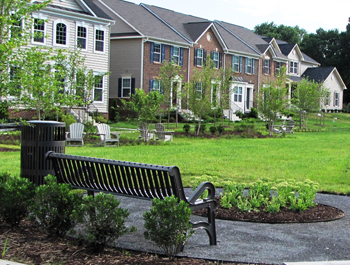Image

Robert A. Goldman, President, Montgomery Housing Partnership
Challenge: Like many areas around the country, Montgomery County, Maryland, faced challenges in providing enough affordable housing to its residents, especially first-time homebuyers and county employees. Initial plans to use a 32-acre parcel of surplus land met with opposition, and the lot sat vacant for more than a decade.
Residents in Montgomery County, Maryland, were struggling with a shortage of affordable housing, especially first-time homebuyers and county employees. County officials came up with an innovative idea to sell a 32-acre parcel of surplus land in its northern suburb of Olney, and use it for affordable housing development by private industry. But the land sat vacant for more than a decade. Its development for affordable housing initially met with opposition from a small but vocal group of local residents who managed to stall developers' efforts.
Montgomery Housing Partnership (MHP) is a private, nonprofit developer that seeks to preserve and expand affordable housing in Montgomery County for low- and moderate-income residents. We accomplish this mission through housing people, empowering families and strengthening neighborhoods. Olney Springs was the first for-sale community MHP has developed.
Through our first collaboration with Elm Street Development, an experienced private developer, Olney Springs has become a groundbreaking model for new home development in Olney that addressed a need for affordable homeownership opportunities for low- and moderate-income families. The 114 homes built on the 32 acres included 34 affordable, quality townhomes for about half the going market rate. Dozens more homes in the development were priced to be in reach of working families.
 Olney Springs represents one of the first for-sale, mixed-income communities in the county to feature a combination of affordable and workforce-priced homes, along with market rate homes.
Olney Springs represents one of the first for-sale, mixed-income communities in the county to feature a combination of affordable and workforce-priced homes, along with market rate homes.For decades, Montgomery County's inclusionary zoning policy mandated 12.5 percent of units built in developments of 20 units of more qualify as affordable. But our ultimate goal for Olney Springs was to go above and beyond the county's minimum standards, with up to 60 percent of properties available at below market rate to low-income and working-class families.
Olney Springs serves the whole range of the area's income spectrum and is a successful model for sustainable low-income ownership.
After the development team launched Olney Springs in June of 2012, the demand for the affordable homes was fast and furious. Construction started in September of 2012, and sales opened a month later. The first new homebuyers moved in during the fall of 2013, and included, among others, a pizza delivery driver, a high school art teacher, a school bus driver, a deputy sheriff and an administrative assistant who works for an insurance company.
For Alani McDonald and her husband, Melvin, Olney Springs represented an opportunity to become a homeowner in the community where she was raised. McDonald was thrilled to enroll her three children in the same elementary school she attended. She has now become a vocal resident leader.
Residents of Olney Springs enjoy some amenities beyond housing. The community features a wooded conservation area with a stream running through it, two playgrounds with picnic tables, and several common areas with seating where neighbors can sit and chat. We felt that having these community-building opportunities were especially important for the new residents.
"It's a great feeling of accomplishment for me to own a home. I absolutely love the quiet neighborhood and open spaces where my son can play and meet new friends his own age. It's a terrific place for us to be a family," says Olney Springs resident Carmen Amaya.
Early on in Olney Springs' development, our team worked hard to enlist the support of local civic and neighborhood associations, with a strong communications plan and proactive community outreach to educate residents about how the new mixed-income community would blend in with existing homes. The surrounding area was relatively affluent. Although the county's idea of a mixed-income community was indeed innovative, not all residents were on board with building new developments for families lower on the income spectrum.
Undeterred, MHP and Elm Street Development collaborated with community groups through the duration of Olney Springs' planning process to address outstanding concerns and to ensure the development's eventual construction. Despite some initial opposition, we were able to successfully convince stakeholders with a few design tweaks, that our mixed-income housing plan was the right fit for the neighborhood.

